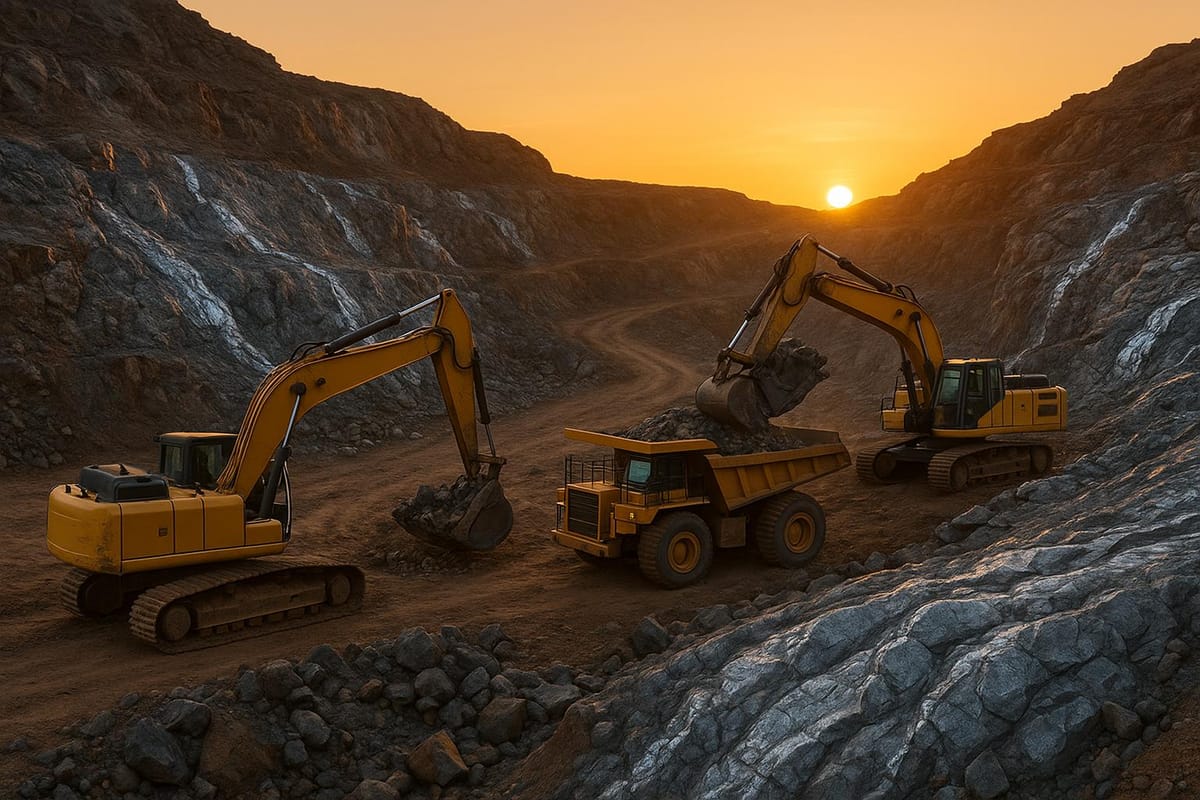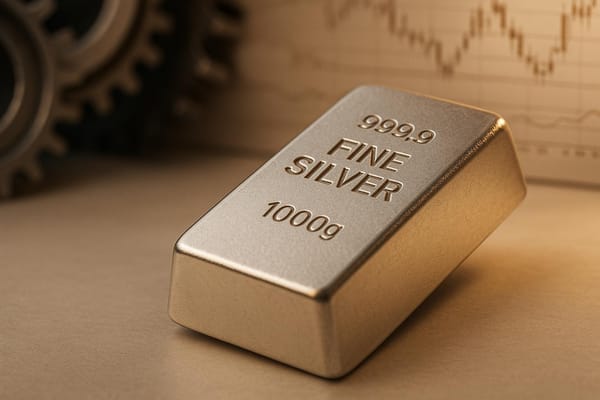How Low-Grade Silver Affects Mining Costs
Low-grade silver mining is raising costs and challenging profitability, pushing companies to innovate and adapt for survival in a volatile market.

Low-grade silver ore is making mining more expensive. As richer deposits become rare, companies must process larger volumes of material to extract the same amount of silver. This raises energy use, labor demands, and equipment costs, tightening profit margins. Investors should watch metrics like All-In Sustaining Costs (AISC) and byproduct revenues to assess company performance.
Key Points:
- What is Low-Grade Ore? Contains less silver per ton, requiring more material to be processed.
- Impact on Costs: Higher energy, equipment, and labor expenses increase AISC.
- Investor Takeaway: Mines with lower AISC and efficient cost management perform better during price fluctuations.
- Cost Management Strategies: Automation, byproduct revenue (e.g., gold, lead, zinc), and reprocessing old tailings help offset rising costs.
Companies that improve efficiency and diversify revenue streams are better positioned to handle market challenges.
Low-Cost Silver Producer Says True Cost Already Over $25 Per Ounce
Challenges of Mining Low-Grade Silver
Extracting silver from low-grade ore presents a tough set of challenges. It demands processing significantly more material, which drives up costs and strains operations. This shift impacts nearly every aspect of mining, from energy consumption to equipment requirements.
More Material Processing Required
When the silver content in ore drops, mining companies are forced to process much larger quantities of material to extract the same amount of silver. Over the past decade, the average grade from the 12 largest silver projects in the world has fallen by 36%. Years of prioritizing higher-grade ore have left vast amounts of lower-grade material behind, adding pressure to today’s operations. This means more energy is needed, waste management becomes more complex, and overall costs - like the All-In Sustaining Costs mentioned earlier - continue to climb.
How Low-Grade Silver Affects Production Costs
When ore grades decline, mining companies face a direct increase in production costs. Extracting the same amount of silver from lower-grade material means processing more rock, which adds to expenses and puts pressure on profit margins. This challenge forces companies to reassess their operations and identify areas where costs can be managed more effectively.
Higher All-In Sustaining Costs (AISC)
All-In Sustaining Costs (AISC) represent the total expense of producing a single ounce of silver, including mining, processing, administrative overhead, and capital investments. Lower silver grades mean more material has to be processed to produce the same amount of silver, inevitably driving up AISC. For example, Pan American Silver's Juanicipio project is projected to achieve an AISC of $6.00–$8.00 per ounce in 2025, significantly lower than the company’s overall guidance of $16.25–$18.25 per ounce for the same period.
In the first quarter of 2025, Pan American Silver reported an AISC of $13.94 per silver ounce - a 16% drop compared to the previous year. This decrease was partly due to cost-saving measures at mines like La Colorada, which saw its AISC fall 29% to $19.72 per ounce, thanks to improved ventilation systems. Cerro Moro, another example, achieved a negative AISC of $4.40 per ounce, largely due to increased gold by-product credits.
Price Sensitivity and Profit Margins
Low-grade mines often operate on razor-thin margins, making them highly vulnerable to shifts in silver prices. When prices dip, high-cost operations can quickly become unprofitable, while lower-cost, high-grade mines are better positioned to weather the storm and continue generating cash flow. This dynamic creates a divide in the market: high-grade mines maintain steady production even during price volatility, while low-grade operations may face shutdowns or significant financial losses. Companies with efficient operations and cost control measures are better equipped to navigate these challenges, maintaining a competitive edge.
High-Cost vs. Low-Cost Producers Comparison
Acquiring high-grade, low-cost mines can significantly improve a company’s cost structure. For instance, First Majestic Silver reported an 11% year-over-year reduction in AISC per silver equivalent ounce, bringing it down to $19.24 in the first quarter of 2025. This improvement was largely attributed to the acquisition of Cerro Los Gatos on January 16, 2025. Cerro Los Gatos added 2.3 million silver equivalent ounces of production and posted an AISC of $13.07 per silver equivalent ounce, making it the company’s most cost-efficient asset.
| Mine Type | AISC Range | Example | Impact on Company |
|---|---|---|---|
| High-Grade, Low-Cost | $6.00 - $13.00/oz | Juanicipio, Cerro Los Gatos | Reduces overall AISC, boosts profitability |
| Average Operations | $16.00 - $20.00/oz | Pan American Silver overall | Reflects standard industry performance |
| Low-Grade, High-Cost | $20.00+/oz | Marginal operations | Prone to losses, risk of shutdowns |
This comparison highlights the strategic advantage of investing in high-grade assets. By acquiring low-cost operations, companies can offset the financial strain caused by higher-cost mines, ensuring they remain competitive and profitable, even in challenging market conditions.
Ways to Manage Low-Grade Silver Mining Costs
As mining companies face the challenge of rising costs in processing low-grade ore, they are finding creative ways to stay profitable. By focusing on operational efficiency, diversifying revenue streams, and optimizing resources, these strategies help offset the higher expenses tied to processing larger volumes of lower-grade material. The goal? To keep production costs down while maintaining competitive profit margins.
Improving Operations and Efficiency
One of the most effective ways to manage costs is by upgrading technology and fine-tuning processes. Mining companies are investing in advanced equipment, automation, and improved processing techniques to squeeze more value out of every ton of ore.
Automation and digital tools are game-changers here. Automated drills, remote-controlled machinery, and real-time monitoring systems reduce the need for large labor forces while boosting precision and efficiency. This is especially critical for low-grade deposits, where processing larger volumes of material is unavoidable.
Another key strategy is metallurgical optimization. By refining processes like crushing, grinding, and flotation, companies can extract more silver from the same amount of ore. This not only improves recovery rates but also lowers the cost per ounce produced.
Using Byproduct Credits
Byproducts like gold, lead, zinc, and copper can significantly offset the costs of silver production. These additional revenue streams often come from the same mining operation, making them a valuable asset.
Gold, in particular, offers a financial edge due to its higher market value. Mines that produce both silver and gold can sometimes achieve negative AISC (all-in sustaining costs). This happens when revenue from gold byproducts exceeds the total production costs, essentially making silver production profitable no matter its market price.
Base metals like lead and zinc also play a vital role. Many silver deposits naturally contain these metals, and their value can provide a steady financial boost. To maximize this, companies keep a close eye on commodity prices and adjust their processing strategies accordingly.
Some companies also use hedging strategies to lock in favorable prices for byproducts. This ensures a predictable revenue stream, even when market conditions fluctuate.
Reprocessing Old Tailings
Reprocessing tailings - previously discarded mining waste - offers another way to cut costs and generate revenue. Older mining operations often left behind tailings containing recoverable amounts of silver and other metals, especially when past technologies were less efficient.
Modern extraction techniques make it possible to recover metals from tailings at lower costs than traditional mining. Since the material has already been mined and crushed, companies can skip expensive steps like blasting and hauling. This reduces both capital and operational expenses, all while boosting production.
Reprocessing tailings also comes with environmental perks. It reduces the mining operation’s footprint and often gains support from regulators and local communities. Companies can even recycle process water from tailings ponds, cutting water use and treatment costs while addressing environmental concerns.
The success of tailings reprocessing depends on the grade and volume of metals left in the waste. Companies typically conduct thorough testing to determine if a project is worth pursuing. When done right, reprocessing can extend a mine’s life and improve its overall economics without the need for major new infrastructure investments.
The Future of Low-Grade Silver Mining
As high-grade silver deposits become harder to find, the mining industry is being forced to rethink its approach. Companies are focusing on improving operations, managing byproducts more efficiently, and adopting cutting-edge technologies to stay profitable. Let’s break down what this means for investors, the role of technology, and the industry’s outlook.
What Investors Should Know
For U.S. investors, the shift to low-grade silver mining presents both risks and opportunities. Companies with solid financials and access to advanced technology have a clear advantage, while those with higher operating costs may face challenges, including potential consolidation. To make informed decisions, investors should pay close attention to metrics like all-in sustaining cost (AISC), revenue from byproducts, and the geographical advantages of a company’s operations. These factors will help assess how well a company can weather market fluctuations and adapt to changing conditions.
Technology and Better Practices
With ore grades declining, mining companies are turning to technology to remain competitive. Automation, artificial intelligence, and sensor-based sorting are being deployed to improve efficiency and reduce waste. Predictive maintenance systems help cut down on equipment downtime, while advanced water management techniques aim to reduce costs and minimize environmental impacts. These advancements are not just improving operations - they’re setting the stage for a broader transformation in how silver is mined.
Silver Mining Industry Outlook
The future of the silver mining industry depends on a delicate balance of cost-saving innovations and strategic exploration. While technological advancements are making it easier to process low-grade ore, the discovery of new, higher-grade deposits remains critical for long-term success. Smaller mining operations are likely to face increasing pressure as costs rise and environmental regulations tighten, potentially leading to industry consolidation. Companies that can adapt their production levels to market demand will be better positioned to handle price fluctuations and maintain profitability in a challenging landscape.
FAQs
What factors do mining companies consider when deciding if processing low-grade silver ore is profitable?
Mining companies assess whether processing low-grade silver ore is worth the effort by weighing production costs against market prices. A critical metric in this evaluation is the breakeven cost - the minimum price per ounce needed to cover production expenses. For instance, the average breakeven cost for silver production has hovered around $26.86 per ounce in recent years.
To gauge profitability, companies compare current silver prices to their production costs. If market prices are higher than the breakeven cost, processing the ore could generate a profit. To stay competitive, especially in unpredictable markets, many companies also focus on cutting expenses. This might include boosting mining efficiency or using cost-effective technologies to streamline operations.
How do byproduct revenues help reduce the costs of mining low-grade silver, and what impact can they have on a company's financial results?
Byproduct revenues play a key role in offsetting the costs of mining low-grade silver. Many mining companies extract silver as a secondary product while focusing on other metals like gold, copper, lead, or zinc. The income generated from these byproducts can help cover operational expenses, effectively lowering the overall cost of producing silver.
For instance, when companies apply byproduct credits, they often report significantly reduced cash costs per ounce of silver - sometimes even reaching negative costs. This financial boost can enhance a company's profitability, making the mining of low-grade silver more manageable and economically viable, even in the face of increasing production challenges.
What are the most effective technologies for lowering the costs of mining low-grade silver ore?
Mining low-grade silver ore comes with its fair share of challenges, primarily due to the high costs of extracting and processing large volumes of material for a relatively small return. But thanks to advancements in technology, this process is becoming more efficient and cost-effective.
Key innovations driving this progress include automated mining equipment, which cuts labor costs while boosting efficiency, and advanced ore-sorting systems that use sensors to more precisely separate valuable silver from waste rock. On top of that, energy-efficient processing methods and new developments in chemical leaching are helping to reduce energy use while improving silver recovery rates.
These technological strides are not just about cutting expenses - they’re also paving the way for mining practices that are more environmentally conscious, a priority that continues to grow in importance across the industry.



